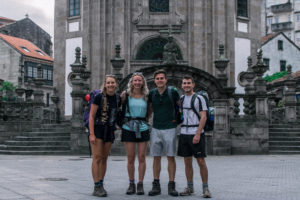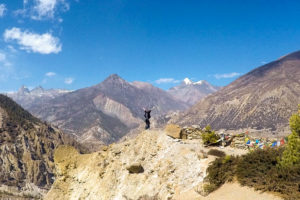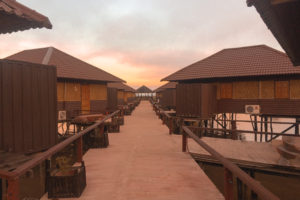What to Expect on the Camino Frances
Before walking the Camino Frances my family had all sorts of ideas on what it would be like, some of which were right, some of which were wrong. One of the most frequent questions we get asked post hike (other than how we didn’t kill each other) is what the trek was like. Here’s a guide as to what you can expect on the Camino Frances…
Contents
The Route
When my family set out on the Camino de Santiago our friends (the ones who had actually heard of it) wondered why we wanted to do a hike that was beside a highway. This is a pretty wide spread perception of the Camino Frances, but in reality the path varied greatly. I’d say the most common type of path is a small dirt or gravel road through country side, but of course you also have remote hiking trails and the occasional highway crossing. The only parts of the trail that we found bad were when the path was going through major cities like Leon. You’d be walking on cement for long time and it was rather tough on your joints. Lots of people will take the bus or a taxi into the major cities to avoid this not so nice parts of the trek.
In terms of way markers or navigation, the Camino Frances is almost comically easy. The path is always super obvious and marked with the tell tale shell signs, yellow arrows or crosses along the path. No one really carries a map because there are very few places to make a wrong turn (of course I still managed to get lost once). (O.K. fine, twice) Even if you do take a wrong turn there are lots of people around to direct you back on to the path.

A cross marking the way

The final shell marker
The Landscape
Many say that the Camino Frances is not a particularly scenic hike and in some ways I agree. There are not as many all encompassing mountain views or awe inspiring panoramas that are common in countries like New Zealand or Canada. Camino Frances has its own definition of beauty though. In terms of the landscape you’ll pass through – it varies greatly. You are walking across an entire country after all!
If you start in France, you start with the infamous first day over the Pyrenees. This is a spectacular day, but it is only one. Immediately after you’ll hit a few days of the fool hills until you hit Pamplona. After Pamplona you have days of rolling hills, farms and beautiful towns. Then comes La Rioja the wine region where you’ll come across more rolling hills, but this time will vineyards all over them. This was likely my favourite region of the hike – what more do you need other than beautiful views and fantastic (cheap) wine! Next you’ll have Burgos, the first big city since Pamplona, which is generally a very flat, kinda boreing region.The next big city is Leon where many people take a rest day because it is such a fantastic city. The remaining 1/2 of the Camino varies from small mountains, farm land, river valleys and forests. Needless to say there is a little bit of something for everyone.
One of the unique aspect of the Camino’s landscape is the number of historic towns you’ll cross (many of these towns older than entire countries). Like everything on the Camino the towns vary a lot. Sadly some of them have become almost completely empty as people move to the surrounding cities. This leaves some of the towns with almost a ghost town feeling, where the only remaining industry is the Camino. Fortunately towns like these are not that common and its generally not that far a walk to get somewhere with a little more soul. There is something to be said about kicking your shoes off after a long hike in a bar thats a hundred years old.

The wine region of La Rioja
The Difficulty
The Camino de Santiago is more of a country side stroll than an outback adventure. You generally pass through towns ever few kilometres all of which will be equipped to offer you a a much needed cerveza stop . There are only a few ‘townless’ stretches, but these tend to be the more crowded parts of the Way as all of the pilgrims are forces to start / stop at the same towns. The many towns are also one of the reasons why the Camino is so accessible, there are regular buses or taxis that run in-between them. On which many people send their bags to meet them at their next albergue. This makes the Camino Frances particularly appealing to the retiree crowd, we were quite impressed at the number of elderly people walking to Santiago. There are some more difficult days on the Camino, most notably the first day over the Pyrenees, but for the most part it is a relatively easy trek. A lot of people don’t even bring proper hiking boots as the most difficult part of the hike is actual the heat, not the terrain!
The People
One of the many things that makes the El Camino unique is the people. No other multi day hike gets as many hikers as the Camino; people from all over the world, different religions and different ages. There are both positive and negative aspects of having so many people on the Camino. On one side it’s busy, albergues are often booked out late in the day and parts of the path are over crowded. However I think it’s mportant to acknowledge that the volume of people is generally not aggressive. There are some days which you can see pilgrims marching down the path as far as you can see, but other days where the path is enclosed and you’ll only pass a few pilgrims a day (because everyone generally walks at a similar pace). Also the people you meet on the trail are one of best reason to hike the Camino!
The Camino has a way of brining people together through shared dinners, blister tips or over a glass of wine at the end of the day. It is incredibly easy to meet people and of these people there is a pretty good chance that they will be pretty interesting. Most importantly these people stick around, you see them again and again almost every day! There is a phenomena in the solo backpacking world called insta-friends (should be an official word by now) where people become friends instantly, but only stay friends for the 2/3 days that they are in the same city. This is not the case with the Camino. When you meet a fellow pilgrim there is a large chance that you will stay them again and again over the next month because most pilgrims tend to walk at a pretty similar pace. People form groups, leave groups then come back to groups of pilgrims. This was particularly fun when my family started to develop a little bit of a reputation as one of the only families walking the Camino. People we’d never met had heard of us through the pilgrim rumour mill!

The line of pilgrims
Overall
While the route, landscape, difficulty and people all make up pretty important aspects of the Camino Frances, the pilgrimage is more than it’s components. It is a deeply personal and individual experience. Everyone has a different reason why they are walking and everyone has a different experience. My experience was deeply affect by the fact that I was walking with my family instead of on my own. In general I’d say if you’re looking for the best multi-day hike the Camino Frances is probably not your best bet, but if your looking for an incredible and unique experience – it’s the trek for you.

Waking up at sunrise for the lat day on the Camino Frances
To see more photos from the Camino Frances check out my galleries for Pt 1 or Pt 2 of the Camino Francis.





